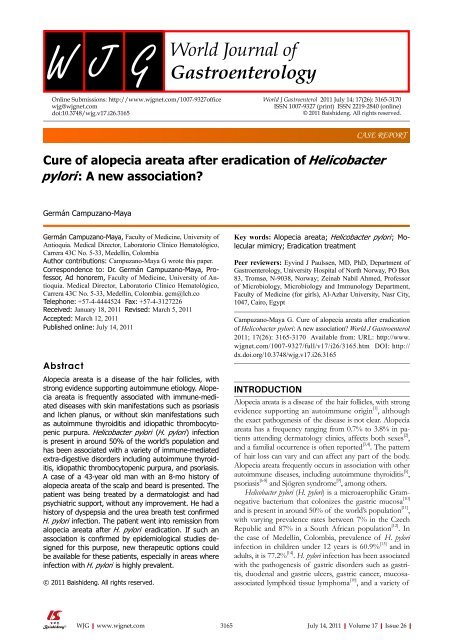26 - World Journal of Gastroenterology
26 - World Journal of Gastroenterology
26 - World Journal of Gastroenterology
Create successful ePaper yourself
Turn your PDF publications into a flip-book with our unique Google optimized e-Paper software.
Online Submissions: http://www.wjgnet.com/1007-9327<strong>of</strong>fice<br />
wjg@wjgnet.com<br />
doi:10.3748/wjg.v17.i<strong>26</strong>.3165<br />
CASE REPORT<br />
Cure <strong>of</strong> alopecia areata after eradication <strong>of</strong> Helicobacter<br />
pylori : A new association?<br />
Germán Campuzano-Maya<br />
Germán Campuzano-Maya, Faculty <strong>of</strong> Medicine, University <strong>of</strong><br />
Antioquia. Medical Director, Laboratorio Clínico Hematológico,<br />
Carrera 43C No. 5-33, Medellín, Colombia<br />
Author contributions: Campuzano-Maya G wrote this paper.<br />
Correspondence to: Dr. Germán Campuzano-Maya, Pr<strong>of</strong>essor,<br />
Ad honorem, Faculty <strong>of</strong> Medicine, University <strong>of</strong> Antioquia.<br />
Medical Director, Laboratorio Clínico Hematológico,<br />
Carrera 43C No. 5-33, Medellín, Colombia. gcm@lch.co<br />
Telephone: +57-4-4444524 Fax: +57-4-31272<strong>26</strong><br />
Received: January 18, 2011 Revised: March 5, 2011<br />
Accepted: March 12, 2011<br />
Published online: July 14, 2011<br />
Abstract<br />
Alopecia areata is a disease <strong>of</strong> the hair follicles, with<br />
strong evidence supporting autoimmune etiology. Alopecia<br />
areata is frequently associated with immune-mediated<br />
diseases with skin manifestations such as psoriasis<br />
and lichen planus, or without skin manifestations such<br />
as autoimmune thyroiditis and idiopathic thrombocytopenic<br />
purpura. Helicobacter pylori (H. pylori ) infection<br />
is present in around 50% <strong>of</strong> the world’s population and<br />
has been associated with a variety <strong>of</strong> immune-mediated<br />
extra-digestive disorders including autoimmune thyroiditis,<br />
idiopathic thrombocytopenic purpura, and psoriasis.<br />
A case <strong>of</strong> a 43-year old man with an 8-mo history <strong>of</strong><br />
alopecia areata <strong>of</strong> the scalp and beard is presented. The<br />
patient was being treated by a dermatologist and had<br />
psychiatric support, without any improvement. He had a<br />
history <strong>of</strong> dyspepsia and the urea breath test confirmed<br />
H. pylori infection. The patient went into remission from<br />
alopecia areata after H. pylori eradication. If such an<br />
association is confirmed by epidemiological studies designed<br />
for this purpose, new therapeutic options could<br />
be available for these patients, especially in areas where<br />
infection with H. pylori is highly prevalent.<br />
© 2011 Baishideng. All rights reserved.<br />
WJG|www.wjgnet.com<br />
3165<br />
<strong>World</strong> J Gastroenterol 2011 July 14; 17(<strong>26</strong>): 3165-3170<br />
ISSN 1007-9327 (print) ISSN 2219-2840 (online)<br />
© 2011 Baishideng. All rights reserved.<br />
Key words: Alopecia areata; Helicobacter pylori ; Molecular<br />
mimicry; Eradication treatment<br />
Peer reviewers: Eyvind J Paulssen, MD, PhD, Department <strong>of</strong><br />
<strong>Gastroenterology</strong>, University Hospital <strong>of</strong> North Norway, PO Box<br />
83, Tromsø, N-9038, Norway; Zeinab Nabil Ahmed, Pr<strong>of</strong>essor<br />
<strong>of</strong> Microbiology, Microbiology and Immunology Department,<br />
Faculty <strong>of</strong> Medicine (for girls), Al-Azhar University, Nasr City,<br />
1047, Cairo, Egypt<br />
Campuzano-Maya G. Cure <strong>of</strong> alopecia areata after eradication<br />
<strong>of</strong> Helicobacter pylori: A new association? <strong>World</strong> J Gastroenterol<br />
2011; 17(<strong>26</strong>): 3165-3170 Available from: URL: http://www.<br />
wjgnet.com/1007-9327/full/v17/i<strong>26</strong>/3165.htm DOI: http://<br />
dx.doi.org/10.3748/wjg.v17.i<strong>26</strong>.3165<br />
INTRODUCTION<br />
Alopecia areata is a disease <strong>of</strong> the hair follicles, with strong<br />
evidence supporting an autoimmune origin [1] , although<br />
the exact pathogenesis <strong>of</strong> the disease is not clear. Alopecia<br />
areata has a frequency ranging from 0.7% to 3.8% in patients<br />
attending dermatology clinics, affects both sexes [2] ,<br />
and a familial occurrence is <strong>of</strong>ten reported [3,4] . The pattern<br />
<strong>of</strong> hair loss can vary and can affect any part <strong>of</strong> the body.<br />
Alopecia areata frequently occurs in association with other<br />
autoimmune diseases, including autoimmune thyroiditis [5] ,<br />
psoriasis [6-8] and Sjögren syndrome [9] , among others.<br />
Helicobacter pylori (H. pylori) is a microaerophilic Gramnegative<br />
bacterium that colonizes the gastric mucosa [10]<br />
and is present in around 50% <strong>of</strong> the world’s population [11] ,<br />
with varying prevalence rates between 7% in the Czech<br />
Republic and 87% in a South African population [12] . In<br />
the case <strong>of</strong> Medellín, Colombia, prevalence <strong>of</strong> H. pylori<br />
infection in children under 12 years is 60.9% [13] and in<br />
adults, it is 77.2% [14] . H. pylori infection has been associated<br />
with the pathogenesis <strong>of</strong> gastric disorders such as gastritis,<br />
duodenal and gastric ulcers, gastric cancer, mucosaassociated<br />
lymphoid tissue lymphoma [10] , and a variety <strong>of</strong><br />
July 14, 2011|Volume 17|Issue <strong>26</strong>|

















